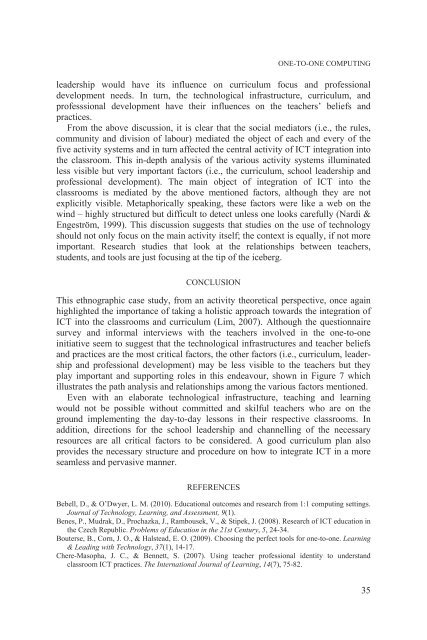1517-creating-holistic-technology-enhanced-learning-experiences
1517-creating-holistic-technology-enhanced-learning-experiences
1517-creating-holistic-technology-enhanced-learning-experiences
Create successful ePaper yourself
Turn your PDF publications into a flip-book with our unique Google optimized e-Paper software.
ONE-TO-ONE COMPUTING<br />
leadership would have its influence on curriculum focus and professional<br />
development needs. In turn, the technological infrastructure, curriculum, and<br />
professsional development have their influences on the teachers’ beliefs and<br />
practices.<br />
From the above discussion, it is clear that the social mediators (i.e., the rules,<br />
community and division of labour) mediated the object of each and every of the<br />
five activity systems and in turn affected the central activity of ICT integration into<br />
the classroom. This in-depth analysis of the various activity systems illuminated<br />
less visible but very important factors (i.e., the curriculum, school leadership and<br />
professional development). The main object of integration of ICT into the<br />
classrooms is mediated by the above mentioned factors, although they are not<br />
explicitly visible. Metaphorically speaking, these factors were like a web on the<br />
wind – highly structured but difficult to detect unless one looks carefully (Nardi &<br />
Engeström, 1999). This discussion suggests that studies on the use of <strong>technology</strong><br />
should not only focus on the main activity itself; the context is equally, if not more<br />
important. Research studies that look at the relationships between teachers,<br />
students, and tools are just focusing at the tip of the iceberg.<br />
CONCLUSION<br />
This ethnographic case study, from an activity theoretical perspective, once again<br />
highlighted the importance of taking a <strong>holistic</strong> approach towards the integration of<br />
ICT into the classrooms and curriculum (Lim, 2007). Although the questionnaire<br />
survey and informal interviews with the teachers involved in the one-to-one<br />
initiative seem to suggest that the technological infrastructures and teacher beliefs<br />
and practices are the most critical factors, the other factors (i.e., curriculum, leader-<br />
ship and professional development) may be less visible to the teachers but they<br />
play important and supporting roles in this endeavour, shown in Figure 7 which<br />
illustrates the path analysis and relationships among the various factors mentioned.<br />
Even with an elaborate technological infrastructure, teaching and <strong>learning</strong><br />
would not be possible without committed and skilful teachers who are on the<br />
ground implementing the day-to-day lessons in their respective classrooms. In<br />
addition, directions for the school leadership and channelling of the necessary<br />
resources are all critical factors to be considered. A good curriculum plan also<br />
provides the necessary structure and procedure on how to integrate ICT in a more<br />
seamless and pervasive manner.<br />
REFERENCES<br />
Bebell, D., & O’Dwyer, L. M. (2010). Educational outcomes and research from 1:1 computing settings.<br />
Journal of Technology, Learning, and Assessment, 9(1).<br />
Benes, P., Mudrak, D., Prochazka, J., Rambousek, V., & Stipek, J. (2008). Research of ICT education in<br />
the Czech Republic. Problems of Education in the 21st Century, 5, 24-34.<br />
Bouterse, B., Corn, J. O., & Halstead, E. O. (2009). Choosing the perfect tools for one-to-one. Learning<br />
& Leading with Technology, 37(1), 14-17.<br />
Chere-Masopha, J. C., & Bennett, S. (2007). Using teacher professional identity to understand<br />
classroom ICT practices. The International Journal of Learning, 14(7), 75-82.<br />
35


